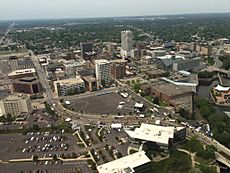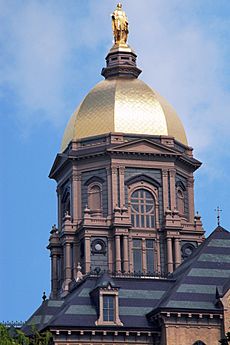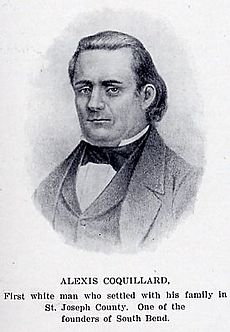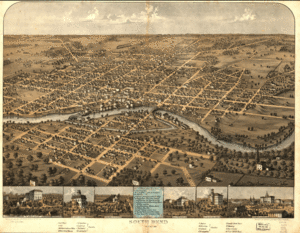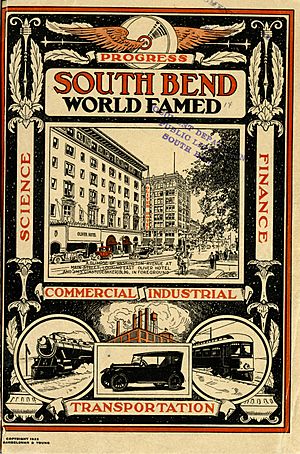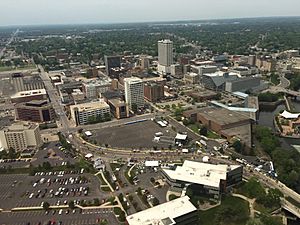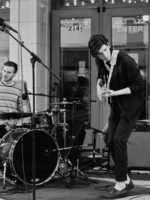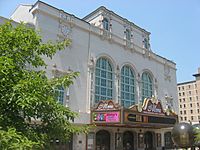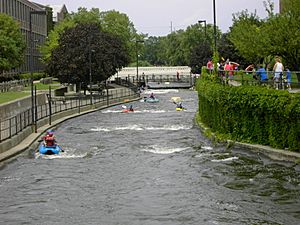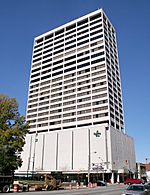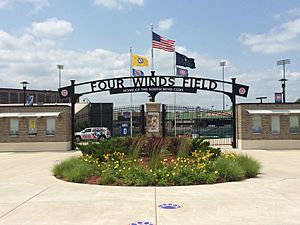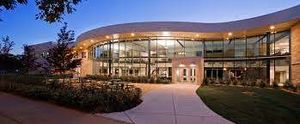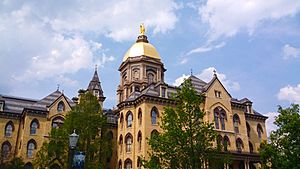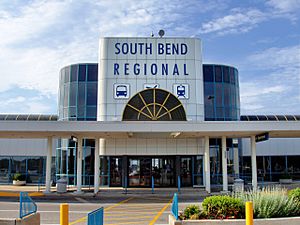South Bend, Indiana facts for kids
Quick facts for kids
South Bend, Indiana
|
|||
|---|---|---|---|
| City of South Bend | |||
|
From top: Downtown South Bend skyline from the East Bank neighborhood, the Golden Dome, the Robert A. Grant Federal Building and U.S. Courthouse in downtown.
|
|||
|
|||
| Nicknames:
Lotion City, Wagon City, Metropolis of Northern Indiana
|
|||
| Motto(s):
"Peace"
|
|||
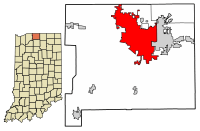
Location of South Bend in St. Joseph County, Indiana.
|
|||
| Country | |||
| State | |||
| County | St. Joseph | ||
| Incorporated (City) | in 1865 by Alexis Coquillard | ||
| Government | |||
| • Type | Strong Mayor-Council | ||
| • Body | South Bend Common Council | ||
| Area | |||
| • City | 42.40 sq mi (109.82 km2) | ||
| • Land | 41.98 sq mi (108.72 km2) | ||
| • Water | 0.43 sq mi (1.10 km2) | ||
| Elevation | 692 ft (211 m) | ||
| Population
(2020)
|
|||
| • City | 103,453 | ||
| • Density | 2,464.57/sq mi (951.58/km2) | ||
| • Metro | |||
| • CSA | |||
| Time zone | UTC−5 (EST) | ||
| • Summer (DST) | UTC−4 (EDT) | ||
| ZIP Codes |
46601, 46604, 46612–46617, 46619–46620, 46624, 46626, 46628–46629, 46634–46635, 46637, 46660, 46680, 46699
|
||
| Area code(s) | 574 | ||
| FIPS code | 18-71000 | ||
| GNIS feature ID | 452796 | ||
| Demonyms | South Bender, Bender | ||
| Interstate Highways | |||
| U.S. Highways | |||
| Major State Roads | |||
| Waterways | St. Joseph River, Juday Creek | ||
| Airports | South Bend International Airport | ||
| Public transit | |||
| GDP | |||
South Bend is a city in and the county seat of St. Joseph County, Indiana, on the St. Joseph River near its southernmost bend, from which it derives its name. As of the 2020 census, the city had a total of 103,453 residents and is the fourth-largest city in Indiana. The metropolitan area had a population of 324,501 in 2020, while its combined statistical area had 812,199. The city is located just south of Indiana's border with Michigan.
The area was settled in the early 19th century by fur traders and was established as a city in 1865. The St. Joseph River shaped South Bend's economy through the mid-20th century. River access assisted heavy industrial development such as that of the Studebaker Corporation, the Oliver Chilled Plow Company, and other large corporations.
The population of South Bend declined after 1960, when it peaked at 132,445. This was chiefly due to migration to suburban areas as well as the demise of Studebaker and other heavy industry. Today, the largest industries in South Bend are health care, education, small business, and tourism. Remaining large corporations based in the area include Crowe, Honeywell, and AM General. The city's economy and culture are influenced by the nearby University of Notre Dame.
In the 2010s, the city's population started to increase for the first time in nearly 50 years. The old Studebaker plant and surrounding area, now called Ignition Park, is being redeveloped as a technology center to attract new industry.
The city was featured in national news coverage of former mayor Pete Buttigieg, a candidate in the 2020 Democratic Party presidential primaries and current Secretary of Transportation in the Biden administration.
Contents
History
Early history
The St. Joseph Valley was long occupied by Native Americans. One of the earliest known groups to occupy what would later become northern Indiana was the Miami tribe. Later, the Potawatomi moved into the region, utilizing the rich food and natural resources found along the river. The Potawatomi occupied this region of Indiana until most of them were forcibly removed in the 1840s. The South Bend area was so popular because its portage was the shortest overland route from the St. Joseph River to the Kankakee River. This route was used for centuries, first by the Native Americans, then by French explorers, missionaries and traders. The French explorer René-Robert Cavelier, Sieur de La Salle, the first white European to set foot in what is now South Bend, used this portage between the St. Joseph River and the Kankakee River in December 1679.
First settlements
The first permanent white settlers of South Bend were fur traders who established trading posts in the area. In 1820, Pierre Frieschutz Navarre arrived, representing the American Fur Company (AFC) of John Jacob Astor. He settled near what is now downtown South Bend. Alexis Coquillard, another agent of the AFC, established a trading post known as the Big St. Joseph Station. In 1827, Lathrop Minor Taylor established a post for Samuel Hanna and Company, in whose records the name St. Joseph's, Indiana was used. By 1829, the town was growing, with Coquillard and Taylor emerging as leaders. They applied for a post office. Taylor was appointed postmaster, and the post office was designated as Southold, Allen County, Indiana. The following year, the name was changed to South Bend, probably to ease confusion, as several other communities were named Southold at the time.
In 1831, South Bend was laid out as the county seat and as one of the four original townships of St. Joseph County with 128 residents. Soon after, design began on what would become the town of South Bend. The town was formally established in 1835 and rapidly grew. In 1856, attorney Andrew Anderson founded May Oberfell Lorber, the oldest business in St. Joseph County. He compiled a complete index of South Bend's real estate records.
In 1841, Schuyler Colfax was appointed St. Joseph County deputy auditor. Colfax purchased the South Bend Free Press and then turned it into the pro-Whig newspaper, the St. Joseph Valley Register. He was a member of the state constitutional convention of 1850 where he opposed the barring of African American migration to Indiana. He joined the Republican party, like many Whigs of his day, and was elected to Congress in 1855 and became Speaker of the House in 1863 under Abraham Lincoln. In 1868, he was elected Vice President under Ulysses S. Grant. Colfax returned to South Bend after his stint in Washington and was buried in the City Cemetery.
Early business
During the late 1830s through the 1850s, much of South Bend's development centered on the industrial complex of factories located on the two races (man-made canals along the St. Joseph River in South Bend). Several dams were created, and factories were built on each side of the river. On October 4, 1851, the first steam locomotive entered South Bend. This led to a general shift of businesses from the river toward the railroad. In 1852, Henry Studebaker set up Studebaker wagon shop, later becoming the world's largest wagon builder and the only one to later succeed as an automobile manufacturer. The Singer Sewing Company and the Oliver Chilled Plow Company were among other companies that made manufacturing the driving force in the South Bend economy until the mid-20th century. Another important economic act was the dredging of the Kankakee River in 1884 to create farmland. During this time period there was a great immigration of Europeans, such as Polish, Hungarian, Irish, German, Italian, and Swedish people to South Bend because the rise of area factories.
South Bend benefited from its location on the Michigan Road, the main north–south artery of northern Indiana in the 19th century. Another significant development occurred near South Bend in 1842, when Father Edward Sorin founded the University of Notre Dame just north of the town. It became a major factor in the area's economy and culture.
Establishment and early history
On May 22, 1865, South Bend was incorporated as a city, and its first elections were held on June 5, 1865, with William G.George elected as its first mayor
Olivet AME was founded in South Bend in March 1870, making it the first African-American church in the city. Olivet AME is still an active African Methodist Episcopal Church, and celebrated its 145th anniversary in 2015.
A sergeant from South Bend fired the first American shells against Germany in World War I.
Later business
Other industries developed in South Bend in the early 20th century, including Birdsell Manufacturing Company, the Bendix Corporation, Honeywell, AlliedSignal, South Bend Lathe Works, the O'Brien Paint Corp., the South Bend Toy Company, South Bend Range, South Bend Bait Company, and South Bend Watch Company. Workers at the Bendix Corporation actually staged the first sit-in strike in American history in 1936. Fast development led to the creation of electric rail transportation throughout the area and, in 1925, the South Shore interurban streetcar service was established from downtown South Bend to downtown Chicago. South Bend was the first community in the United States to have an electrified trolley system (even though it was a few years before it was usable and profitable).
On June 30, 1934, the Merchants National Bank in South Bend was the last bank to be robbed by the notorious "Dillinger gang".
Recent history
In 1949, legendary percussionist Lionel Hampton was informed that his concert at South Bend's Palais du Royale would be a blacks only event; he threatened to call for a boycott of the venue, and the affair proceeded as an integrated evening, which newspapers said led to all attendees breaking out in "paroxysms of ecstasy."
By 1950, more than half of all employment was in the manufacturing sector. Due to economic difficulties, Studebaker closed its automotive manufacturing plants in South Bend in December 1963. A general decline in manufacturing soon followed as industry was being restructured nationwide. By the year 2000, manufacturing was only 16 percent of the local economy. Due to the severe loss of jobs, the city's population decreased by nearly 30,000 people during that period.
In 1984, South Bend community leaders began seeking a minor-league baseball team for the city. A stadium was constructed in 1986 and a 10-year player-development contract was signed with the Chicago White Sox. The team would be known as the South Bend White Sox. In 1994, the team's name was changed to the South Bend Silver Hawks. The Silver Hawks changed their name to The South Bend Cubs in 2015. They are a Class A minor league affiliate of the Chicago Cubs in the Midwest League.
In 2015, the City of South Bend celebrated its 150th birthday. The celebration, lasting a year long, culminated with a celebration along the St. Joseph River with the lighting of the first River Lights. Mayor Pete Buttigieg welcomed the coming of the next 150 years of South Bend's heritage accompanied by five previous South Bend mayors: Steve Luecke, Joe Kernan, Roger Parent, Peter Nemeth and Jerry Miller.
As of 2015, the city began seeing modest population growth of 286 for the first time in nearly fifty years. The old Studebaker plant in South Bend is currently a new tech center, as the city is trying to attract the new industry. The area where the plants were abandoned is now called Ignition Park and is attracting new businesses.
Geography
South Bend is located at 41°40′21″N 86°15′19″W / 41.67250°N 86.25528°W (41.672597, −86.255157), 5 mi (8.0 km) from the Michigan border and approximately equidistant from Illinois and Ohio. The city is 93 mi (150 km) from Chicago. The nearest shore of Lake Michigan is 20 mi (32 km) away.
According to the 2010 census, South Bend has a total area of 41.877 square miles (108.46 km2), of which 41.46 square miles (107.38 km2) (or 99%) is land and 0.417 square miles (1.08 km2) (or 1%) is water.
Cityscape
The St. Joseph River flows from the east end of the city turning north near the city center, giving South Bend its name at the bend in the river. South Bend is located on the North-South continental divide, and the river flows northwest into Lake Michigan. The downtown area is located in the north-central part of the city along the St. Joseph River. Notre Dame, Indiana, is directly adjacent to the north. The city extends further north on the west side, mainly with manufacturing and distribution facilities near the South Bend International Airport. Mishawaka, Indiana, is adjacent to South Bend's east side.
Climate
South Bend has a humid continental climate, with a Köppen climate classification of Dfa. Lake Michigan exerts a great influence on the climate of South Bend, including lake effect snow in winter and a tendency to moderate temperatures year round. June through August are the warmest months, with average temperatures above 69 °F (21 °C). Normally, 42 days with thunderstorms occur each year. The snowiest month is usually January, with snowfall normally recorded from October through April. On average, South Bend receives 81.8 inches (208 cm) of snow per year. Spring and fall can be mild and overcast, but also severely stormy at times with 293 partly cloudy to cloudy days each year.
| Climate data for South Bend, Indiana (South Bend Regional Airport), 1981–2010 normals | |||||||||||||
|---|---|---|---|---|---|---|---|---|---|---|---|---|---|
| Month | Jan | Feb | Mar | Apr | May | Jun | Jul | Aug | Sep | Oct | Nov | Dec | Year |
| Record high °F (°C) | 68 (20) |
74 (23) |
85 (29) |
91 (33) |
96 (36) |
106 (41) |
109 (43) |
105 (41) |
99 (37) |
92 (33) |
82 (28) |
70 (21) |
109 (43) |
| Average high °F (°C) | 31.8 (−0.1) |
35.6 (2.0) |
47.0 (8.3) |
59.9 (15.5) |
70.4 (21.3) |
79.8 (26.6) |
83.3 (28.5) |
81.3 (27.4) |
74.4 (23.6) |
62.0 (16.7) |
48.6 (9.2) |
35.5 (1.9) |
59.1 (15.1) |
| Average low °F (°C) | 17.9 (−7.8) |
20.7 (−6.3) |
28.7 (−1.8) |
38.9 (3.8) |
48.8 (9.3) |
58.9 (14.9) |
63.3 (17.4) |
61.9 (16.6) |
53.8 (12.1) |
42.8 (6.0) |
33.4 (0.8) |
22.6 (−5.2) |
41.0 (5.0) |
| Record low °F (°C) | −22 (−30) |
−20 (−29) |
−13 (−25) |
11 (−12) |
24 (−4) |
35 (2) |
42 (6) |
40 (4) |
29 (−2) |
12 (−11) |
−7 (−22) |
−18 (−28) |
−22 (−30) |
| Average precipitation inches (mm) | 2.28 (58) |
1.95 (50) |
2.41 (61) |
3.23 (82) |
3.83 (97) |
3.79 (96) |
4.00 (102) |
3.76 (96) |
3.53 (90) |
3.32 (84) |
3.27 (83) |
2.61 (66) |
37.97 (964) |
| Average snowfall inches (cm) | 21.6 (55) |
15.1 (38) |
6.8 (17) |
1.4 (3.6) |
0 (0) |
0 (0) |
0 (0) |
0 (0) |
0 (0) |
0.4 (1.0) |
4.7 (12) |
17.3 (44) |
70.4 (179) |
| Average precipitation days (≥ 0.01 in) | 15.7 | 11.8 | 12.7 | 13.2 | 12.3 | 10.3 | 9.5 | 9.9 | 9.9 | 10.9 | 13.4 | 15.8 | 145.4 |
| Average snowy days (≥ 0.1 in) | 13.1 | 9.2 | 5.3 | 1.7 | 0 | 0 | 0 | 0 | 0.1 | 0.4 | 3.6 | 10.9 | 44.3 |
| Source 1: The Weather Channel (extremes) | |||||||||||||
| Source 2: NOAA | |||||||||||||
Demographics
| Historical population | |||
|---|---|---|---|
| Census | Pop. | %± | |
| 1850 | 1,652 | — | |
| 1860 | 3,832 | 132.0% | |
| 1870 | 7,206 | 88.0% | |
| 1880 | 13,280 | 84.3% | |
| 1890 | 21,819 | 64.3% | |
| 1900 | 35,999 | 65.0% | |
| 1910 | 53,684 | 49.1% | |
| 1920 | 70,983 | 32.2% | |
| 1930 | 104,193 | 46.8% | |
| 1940 | 101,268 | −2.8% | |
| 1950 | 115,911 | 14.5% | |
| 1960 | 132,445 | 14.3% | |
| 1970 | 125,850 | −5.0% | |
| 1980 | 109,727 | −12.8% | |
| 1990 | 105,511 | −3.8% | |
| 2000 | 107,789 | 2.2% | |
| 2010 | 101,166 | −6.1% | |
| 2020 | 103,453 | 2.3% | |
| U.S. Decennial Census 2010-2020 |
|||
2020 census
| Race / Ethnicity | Pop 2010 | Pop 2020 | % 2010 | % 2020 |
|---|---|---|---|---|
| White alone (NH) | 56,474 | 51,891 | 55.82% | 50.16% |
| Black or African American alone (NH) | 26,496 | 26,102 | 26.19% | 25.23% |
| Native American or Alaska Native alone (NH) | 310 | 300 | 0.31% | 0.29% |
| Asian alone (NH) | 1,295 | 1,549 | 1.28% | 1.50% |
| Pacific Islander alone (NH) | 55 | 57 | 0.05% | 0.06% |
| Some Other Race alone (NH) | 233 | 651 | 0.23% | 0.63% |
| Mixed Race/Multi-Racial (NH) | 3,189 | 5,654 | 3.15% | 5.47% |
| Hispanic or Latino (any race) | 13,116 | 17,249 | 12.96% | 16.67% |
| Total | 101,168 | 103,453 | 100.00% | 100.00% |
Note: the US Census treats Hispanic/Latino as an ethnic category. This table excludes Latinos from the racial categories and assigns them to a separate category. Hispanics/Latinos can be of any race.
2010 census
As of the census of 2010, there were 101,168 people, 39,760 households, and 23,526 families residing in the city. The population density was 2,440.1 inhabitants per square mile (942.1/km2). There were 46,324 housing units at an average density of 1,117.3 per square mile (431.4/km2). The racial makeup of the city was 60.5% White, 26.6% African American, 0.5% Native American, 1.3% Asian, 0.1% Pacific Islander, 6.9% from other races, and 4.2% from two or more races. Hispanic or Latino of any race were 13.0% of the population.
There were 39,760 households, of which 33.1% had children under the age of 18 living with them, 34.9% were married couples living together, 18.9% had a female householder with no husband present, 5.4% had a male householder with no wife present, and 40.8% were non-families. 33.3% Of all households were made up of individuals, and 11.4% had someone living alone who was 65 years of age or older. The average household size was 2.48 and the average family size was 3.19.
The median age in the city was 33.3 years. 27.3% of residents were under the age of 18; 10% were between the ages of 18 and 24; 27.1% were from 25 to 44; 23.1% were from 45 to 64; and 12.5% were 65 years of age or older. The gender makeup of the city was 48.4% male and 51.6% female.
Ethnicity
Per the 2013 American Community Survey of the U.S. Census Bureau, the following ancestries were reported: African-American - 26%, German - 14.8%, Irish - 10.4%, Polish - 8.2%, English - 5.0%, American - 3.3%, Italian - 2.6%, Hungarian - 2.4%, French - 2.0%, Dutch - 1.4%, Swedish - 1.1%, Belgian - 0.9%.
Arts and culture
Culture
South Bend was influenced by a large influx of Polish Catholic immigrants in the late 19th century. Dyngus Day is widely celebrated on the Monday after Easter and is the beginning of the city elections campaign season. Fat Tuesday is also celebrated in South Bend, with paczkis being a staple food product in the city for the day. The city and surrounding county have 23 Catholic churches, 11 Catholic schools and three Catholic universities (the University of Notre Dame, Holy Cross College, and Saint Mary's College, all located in the adjacent city of Notre Dame).
Music festivals
The city has several annual festivals. The South Bend International Festival began ten years ago as the South Bend Reggae Festival and now features local and international musical artists who perform in African, Latino, and American cultural styles. Proceeds from the festival are given to the Pangani Foundation of South Bend, which provides medical supplies to hospitals in Malawi.
WBYT FM - B100 (Country Station) hosts an Annual All Day Country Concert, with over 37,000 free tickets in early September.
The World Pulse Festival, broadcast by LeSEA Broadcasting network, is held annually in South Bend. It is hosted by Pulse FM, a local Christian music radio station. The event is an annual Contemporary Christian music festival, attracting more than 50,000 visitors each year.
In 2013, a new annual festival began in South Bend called South by South Bend, named after the famous South By Southwest of Austin, TX. The festival is a celebration of the local music scene, with local bands and artists performing on the park grounds and other public venues around the city. The goals of the festival include strengthening the bond between the communities of South Bend and Notre Dame, supporting local artistic expression, and promoting local business. In 2015, the festival was renamed Sounds by South Bend, to avoid confusion with the Austin festival and more accurately represent the purpose of the event.
Museums, arts and entertainment
The South Bend Museum of Art is located in Century Center in downtown South Bend. The museum was opened to the public in March 1996, and features a variety of artists from South Bend and the Michiana region. Currently, over 850 works are featured in the permanent collection. The museum also offers several classes and workshops for adults and children.

The History Museum
The History Museum is the public name of the Northern Indiana Historical Society, the second-oldest historical society in Indiana, which was established in 1867 to collect and interpret the history of the northern Indiana region by St. Joseph County's leading citizens. The Oliver Mansion (also known by its original name, Copshaholm) is one of the central features of the museum. The 38-room mansion was built in 1895 and is currently listed in the National Register of Historic Places. The home was built by Joseph Doty Oliver, the son of James Oliver, the founder of the Oliver Farm Equipment Company, once the largest plow manufacturer in the United States. In addition to the Oliver Mansion and the Workers Home (a 1920s Polish-American family home), and museum includes areas dedicated to the history of the St. Joseph River Valley, the University of Notre Dame, the All-American Girls Professional Baseball League, and the Kidsfirst Children's Museum.
Studebaker National Museum
The Studebaker National Museum holds a large collection of wagons and automobiles from the 150-year history of the Studebaker Corporation. The museum began as a collection of wagons and automobiles produced by Studebaker, including the presidential carriages of Lincoln, McKinley, Harrison, and Grant. The company donated the collection to the city of South Bend in 1966. The collection was housed in various locations from Century Center to its current location in downtown South Bend, adjacent to The History Museum. The two museums share one campus, and together form The Museums at Washington and Chapin. The former South Bend mansion of Clement Studebaker, named Tippecanoe Place, is now a restaurant.
Theatric buildings
The Morris Performing Arts Center, built in 1922, included the Palace Theater, a venue for vaudeville. The theatre's heyday was in 1940 with the premiere of Knute Rockne, All American, starring Ronald Reagan. A crowd estimated at 24,000 gathered outside. The theater was scheduled for demolition in 1959, when E. M. Morris purchased the facility and sold it to the city for one dollar, after which it was renamed the Morris Civic Auditorium. A total renovation was completed in 2000. The Morris Performing Arts Center also includes the Palais Royale Ballroom, on which restoration was recently completed. The center houses the Broadway Theater League and the South Bend Symphony Orchestra. The orchestra's Shanghai-born conductor, Tsung Yeh, was the first conductor ever to hold music directorships of both a western symphony orchestra and a major Chinese orchestra. Marian High School holds its graduation ceremony at the theater.
South Bend is also home to The South Bend Hot Patooties, a group that performs a shadowcast of The Rocky Horror Picture Show. The group has performed at various South Bend venues including the State Theater, Legends of Notre Dame, The Potawatomi Conservatories, and the historic Birdsell Mansion.
The South Bend Civic Theatre, founded in 1957, was for many years located at The Firehouse, 701 Portage Avenue. In 2007, a new theatre opened at 403 North Main Street, in what was formerly the Scottish Rite Building. The new facility includes a 209-seat main-stage auditorium and a 90-seat "black-box" studio theatre. The South Bend Civic Theatre produces more than a dozen plays per year, including several productions in its Family Series.
Other
The Fischoff National Chamber Music Association, sponsor of the world's largest chamber music competition, was founded in South Bend in 1973. The annual Fischoff National Chamber Music Competition is held on the campus of the University of Notre Dame.
Schuyler Colfax, the 17th Vice President of the United States, is interred in South Bend City Cemetery.
Parks and recreation
The Potawatomi Zoo opened in 1902 and is the oldest in the state. It was founded in Leeper Park and was moved to its current location in Potawatomi Park in 1912. It features more than 400 animals in its 23 acres (93,000 m2). The zoo is run by the South Bend Parks and Recreation Department. Along with the zoo, the South Bend Parks and Recreation department operates over 50 parks, golf courses, and recreational areas throughout the city. Notable parks include Rum Village Park, which has a disc golf course, mountain bike trails, hiking trails, and a nature center, and Potawatomi Park, which has the region's largest Universally Accessible Playground and an outdoors Performance Arts Pavilion and viewing area.
Near the Potawatomi Zoo are the Potawatomi Greenhouses and the Ella Morris and Muessel-Ellison Botanical Conservatories. The greenhouses were originally constructed in the 1920s, with the conservatories added in the 1960s. In 2007, the greenhouses and conservatories were in danger of closing due to increased operating costs, but a campaign by the Botanical Society of South Bend was able to raise funds to keep the facilities operating.
The city is home to the East Race Waterway, which is used for boating and water sports (see above).
While developing the 2006 City Plan, the city's 20-year comprehensive plan, citizens said the encouragement of bicycling as a form of alternative transportation was a top priority. In 2010, South Bend became one of 303 communities in the United States to be recognized as a "Bicycle-Friendly Community" by the League of American Bicyclists due to the city's "remarkable commitments to bicycling. The city has developed a long-term plan for building a 116-mile South Bend Bikeway network. As of late 2014, 66.8 miles of bicycle routes have been established: 17.4 miles of multipurpose paths separated from streets, 17.0 miles of striped bike lanes, and 32.4 other designated on-street routes. The area is also served by the St. Joseph County Parks Dept, which maintains eight different parks and recreation areas. The Parks department serves the metro area and is headed by a permanent staff (Director- Evie Kirkwood) and an appointed Board (Larry Catanzarite - President)
Places of worship
South Bend is home to over 100 places of worship, including mostly Christian churches, three synagogues, and one mosque.
Christian churches
- Calvary Baptist Church
- Cathedral of St. James (Episcopal)
- Christ the King Catholic Church
- Christ the King Lutheran Church (ELCA)
- Church of the Holy Trinity (Episcopal)
- Clay Church (United Methodist)
- Community Baptist Church
- Community Congregational Church
- Corpus Christi Catholic Community
- Emmaus Evangelical Lutheran Church (LCMS)
- Evangel Heights United Methodist Church
- Faith Apostolic Ministries
- Fellowship Baptist Church
- First Baptist Church South Bend
- First Church of Christ, Scientist
- First Presbyterian Church
- First Unitarian Church of South Bend
- First United Methodist Church
- Gloria Dei Lutheran Church (ELCA)
- The Grace Place
- Grace United Methodist Church
- Holy Cross Catholic Church
- Holy Family Catholic Church
- Holy Trinity Lutheran Church (ELCA)
- New Life Assembly of God
- Oak Tree Community Church Baptist
- Our Lady of Hungary Catholic Church
- Our Redeemer Lutheran Church (LCMS)
- Sacred Heart of Jesus Catholic Church
- Southlawn United Methodist Church
- St. Adalbert Catholic Church
- St. Andrew Greek Orthodox Church
- St. Anthony de Padua Catholic Church
- St. Augustine Catholic Church
- St. Casimir Catholic Church
- St. Hedwig Catholic Church
- St. John the Baptist Catholic Church
- St. Joseph Catholic Church
- St. Jude Catholic Church
- St. Mary National Catholic Church
- St. Matthew Cathedral (Catholic)
- St. Michael & All Angels Episcopal Church
- St. Nectarios Orthodox Church (ROCOS)
- St. Patrick Catholic Church
- St. Paul Lutheran Church (LCMS)
- St. Paul's Memorial United Methodist Church
- Sts. Peter and Paul Serbian Orthodox Church
- St. Peter's United Church of Christ
- St. Stanislaus Catholic Church
- St. Thérèse, Little Flower Catholic Church
- South Bend First Church of the Nazarene
- South Side Baptist Church
- Southgate Church (Assemblies of God)
- Zion United Church of Christ
Non-Christian places of worship
- Hebrew Orthodox Congregation
- Islamic Society of Michiana
- Sinai Synagogue (Conservative Judaism)
- Temple Beth-El (Reform Judaism)
Former places of worship
- B'nai Israel Synagogue (Reconstructionist; formerly Orthodox), closed in 1990
- First Presbyterian Church, congregation moved to new building
Sister cities
South Bend has three sister cities:
 Częstochowa (Poland)
Częstochowa (Poland) Arzberg (Germany)
Arzberg (Germany) Guanajuato (Mexico)
Guanajuato (Mexico)
Economy
South Bend's location on the St. Joseph River led to an industrial-based economy in the late 19th century and early-to-mid-20th century. In 1923, industrialist and entrepreneur Vincent H. Bendix selected South Bend as the site of his new manufacturing plant for automotive parts. He chose South Bend primarily because it was on a rail line midway between Chicago and Detroit, the two automotive manufacturing centers of the United States at the time. Eventually, the Bendix corporation built a vast manufacturing complex on its South Bend acreage served by the major railroads, including a huge shipping and receiving building where railroad cars could enter at one end, unload, and depart at the opposite end.
By the end of World War II, manufacturing began to diminish. The Studebaker plant, which had at one time employed 45,000 persons, closed in 1963; its engine block plant shuttered the following year. Parts of the Bendix factory complex were later acquired and divided between Honeywell Corporation and Bosch Corporation respectively. Honeywell Aerospace continues to manufacture aviation products at its former Bendix facility. In 2010, Bosch announced that it would cease all operations at its Bendix plant location in South Bend by the end of 2011. Bosch vacated the building entirely in October 2012. Curtis Products of South Bend moved into the building in May 2013.
Employers
Since the 1960s, education, health care, and small business have come to the forefront of South Bend's economy, though the city has never regained the level of prosperity it enjoyed before that time. Nearby University of Notre Dame is a large contributor to the local economy. The university is the second largest employer in the city and in St. Joseph County, employing 6,086 people.
Health care is another major contributor to the South Bend economy. In 2012, Memorial Health System announced that it was merging with Elkhart General Hospital, located in Elkhart County, to form Beacon Health System. Beacon is the largest employer in the city and in St. Joseph County, employing 7,088 people. Other notable businesses include Honeywell, Bosch, and PEI Genesis. AM General, Crowe Horwath, and Tire Rack all have corporate headquarters in South Bend.
According to the 2017 Comprehensive Annual Financial Report, the city's top employers are:
| # | Employer | # of employees |
|---|---|---|
| 1 | Beacon Health System (Memorial) | 7,088 |
| 2 | University of Notre Dame | 6,086 |
| 3 | South Bend Community School Corporation | 3,432 |
| 4 | Indiana University South Bend | 1,401 |
| 5 | St. Joseph County | 1,377 |
| 6 | City of South Bend | 1,285 |
| 7 | Four Winds Casino | 1,200 |
| 8 | AM General | 1,200 |
| 9 | The South Bend Clinic | 854 |
| 10 | Press Ganey | 850 |
Technology
Efforts are under way to spur economic growth in South Bend. The St. Joe Valley Metronet is a 50-mile dark fiber optic network that encircles South Bend and Mishawaka that allows for strong telecommunications connectivity. The South Bend Metronet, named Zing, is bringing more high-tech firms to the city and surrounding area. This telecommunications network has allowed for the advent of various data centers in South Bend, which serves as a hub between Chicago, Indianapolis, Detroit, and Cincinnati. In 2015, the City of South Bend announced it will provide free wireless internet access via the Metronet in the city's downtown and East Bank areas.
The Union Station Technology Center was purchased from the city in 1979 and is currently Northern Indiana's largest data center. There are currently plans to extend the data center into a fully operating high tech data hub in the old Studebaker "Ivy Tower" assembly plant next door, creating what will be called the Renaissance District.
Innovation Park and Ignition Park
Innovation Park and Ignition Park, dual-certified technology parks, have attracted technology businesses to South Bend. Located across the street from the University of Notre Dame, Innovation Park was completed in 2009 and houses innovative researchers from companies and the university. Ignition Park, located just south of the downtown area, is planned to become home to 3 million square feet of high tech space on 140 acres of land previously owned by the Studebaker Corporation. The first tenant, Data Realty, moved into the location in the fall of 2012. The second building in the new park, a research and testing facility for massive turbo machinery is part of a partnership between the city, General Electric, Great Lakes Capital, Indiana Michigan Power, University of Notre Dame, and the state of Indiana.
Redevelopment
Redevelopment is underway for some of the abandoned industrial facilities, with the abandoned Oliver Corporation buildings being the most recent example of reclaimed property. The city also faced programs with large swaths of vacant housing after the decline of the manufacturing industry. In 2013, 1,347 homes were vacant or abandoned. The city created the Vacant and Abandoned Properties Initiative in February 2013, which aimed to take care of 1,000 vacant or abandoned homes in 1,000 days, either through demolition, repairs, or some other satisfactory means.
The Smart Street Initiative, a 20-year plan to make the city safer for pedestrians, bicyclists, and motorists, began in 2013 with the conversion of one-way streets to two-way streets, to bring more businesses to the area, create shorter travel routes, and to reduce speeding. The other part of the initiative is the West Side Main Streets Plan, a revitalization plan for the Lincoln Way West and Western Avenue corridor focusing on guiding business owners, residents, and developers to improve the street front by offering a reimbursement on exterior improvements from the city and the Urban Enterprise Association.
Recognition
In 2012, Kiplinger's Personal Finance ranked South Bend eighth in the "Ten Best Cities for Cheapskates". South Bend was also ranked among the 40 hottest real estate markets for business by Expansion Management magazine, and Smart+Connected Communities Institute featured South Bend as one of the top ten cities worldwide that is reinventing themselves through technology.
Sports
South Bend Lions FC
A USL2 soccer franchise named in November 2019, located in South Bend. The team plays at TCU School Field with an inaugural season in Summer of 2020.
South Bend Cubs
The city is home to the South Bend Cubs, a Class A Minor League Baseball team, which plays at Four Winds Field at Coveleski Stadium in downtown South Bend. In 2014, the franchise changed its name and logo to the South Bend Cubs and became affiliated with the Chicago Cubs; prior to this, it had been known as the South Bend Silver Hawks and affiliated with the Arizona Diamondbacks. In 2005, the franchise nearly moved to Marion, Illinois, but a group of investors, led by former Indiana governor and former South Bend mayor Joe Kernan, bought the Silver Hawks in order to ensure the team stayed in South Bend.
Buildings and stadium
The Ballpark Synagogue is a 1901 synagogue building on the grounds of the ballpark, which serves as the team's fan store. It is the nation's only ballpark synagogue and it is available for weddings and other events. The stadium is also used for multiple community events. In 2015, the South Bend Cubs broke their previous ticket sales record, with a total of 347,678 tickets sold.
South Bend Roller Girls
The city also hosts the South Bend Roller Girls, the city's non-profit flat-track roller derby league. Founded in March 2010, the league has worked to support fundraising for local charities, such as the Salvation Army's Adopt-A-Family program, the American Cancer Society's Making Strides Against Breast Cancer, and the St. Joe County Humane Society. The South Bend Roller Girls traveling/competitive team, The Studebreakers, is named after the historic Studebaker Corporation. The team is a member of the Women's Flat Track Derby Association.
East Race Waterway
South Bend is home to the first artificial whitewater center in North America, the East Race Waterway, adjacent to Century Center. The East Race Waterway is one of only four operating artificial whitewater facilities in the United States, the others being Dickerson Whitewater Course (in Dickerson, Maryland), U.S. National Whitewater Center (in Charlotte, North Carolina), Adventure Sports Center International (in McHenry, Maryland), and Riversports Rapids (in Oklahoma City, Oklahoma). The East Race Waterway is one of only six such facilities to have ever been operated in the US, the others being the four aforementioned courses and the now-defunct Ocoee Whitewater Center (in Ducktown, Tennessee). Prior to the opening of Riversports Rapids, the East Race had long been the only such US facility not located in an East Coast state. The waterway is closed as of 2021 because a hydroelectric dam is being built at the source.
Other sports
During World War II, the South Bend Blue Sox All-American Girls Professional Baseball League team was formed in the city. The team participated in all the league's seasons from 1943 to 1954.
High-school sports are also a big draw in South Bend.
The Notre Dame Fighting Irish provide much of the sports action for the South Bend locale. Football Saturdays have become a major event for the city, attracting fans who come to watch the game and have tailgate parties. Notre Dame basketball games are also popular, along with other university sports.
The Blackthorn Golf Course in South Bend is home to the Four Winds Invitational of the Symetra Tour.
Along with Notre Dame, South Bend was the site of the VII Special Olympics Summer World Games in 1987. Notre Dame also hosted the 1983 AAU Junior Olympics.
Education
Colleges
The South Bend area contains several institutions of higher education.
- Indiana University South Bend is the third-largest campus in the Indiana University system. Its total enrollment during the 2019–20 school year was 5,092 students.
- Purdue Polytechnic South Bend
- Ivy Tech Community College
- Trine University
Colleges located near South Bend:
- University of Notre Dame
- Saint Mary's College
- Holy Cross College
- Bethel University
K–12 schools
Public schools in South Bend are operated by the South Bend Community School Corporation. The corporation runs 17 primary centers (grades K–5), seven intermediate centers (mostly grades 6–8), four high schools (grades 9–12) and an alternative school (grade 9-12), serving 16,725 students during the 2019–20 school year. In 2018–19, the school district received an accountability grade overall of C.
There are also several private schools: namely, Trinity School at Greenlawn, recipient of four Blue Ribbon Awards from the U.S. Department of Education, and The Stanley Clark School. Additionally, the Diocese of Fort Wayne-South Bend operates 11 parochial grade schools and one high school in South Bend. This includes St Thomas More Academy and St. Joseph School, National Register of Historic Places listing and 2-time National Blue Ribbon Award recipient.
Public library
South Bend is served by the St. Joseph County Public Library with a Main Library, and branches in Francis, German, and Lasalle townships. There are a total of ten branches of the public library system throughout the county and from which any library card holder can select. The main library is currently closed through summer 2021 for extension renovation and expansion.
Transportation
Roads
South Bend's location around the St. Joseph River has influenced the development of its streets. While city streets mainly follow a grid plan, road development also adapted to the river's path. South Bend is connected to state and national highway systems by State Roads 2, 23, and 933; U.S. Route 20 and 31; and Interstate 80 and 90, the Indiana Toll Road. Original routes of both the Lincoln Highway and the Dixie Highway also pass through South Bend. South Bend was also a town along the intrastate Michigan Road.
Parts of Eddy Street, Sample Street, Chapin Avenue, Marion Street, and Madison Street form an incomplete loop around the downtown area; this was formerly referred to as "the innerbelt". Portions of State Roads 23 and 933 follow this route.
For transportation around the South Bend metro area, there is the St. Joseph Valley Parkway, designated in places as US 20, US 31, and State Road 331, which bypasses South Bend to the south and west, and connects to Michigan to the north and the greater Elkhart area to the east. The Indiana Toll Road (Interstates 80 and 90) passes through northern South Bend.
Intercity bus service
South Bend is served by a single Greyhound station. The busses had operated out of the airport until 2019, when they relocated to a leased portion of the South Street Station.
Transit
Public transportation in South Bend is controlled by Transpo (South Bend Public Transportation Corporation). Transpo operates bus routes between stations located in South Bend and Mishawaka and provides services to the towns of Osceola and Roseland, from Monday through Saturday. In 2006, the Transpo fleet switched to biodiesel fuel. In 2015, Transpo added 16 new buses powered by compressed natural gas. The Transpo facility is also the first LEED Platinum transit facility in the country. The South Street Station serves as the main hub most passengers, with multiple platforms and buses arriving frequently. Connections can be made to the Interurban Trolley in Mishawaka.
Aviation
South Bend serves as the transportation hub for Michiana. The South Bend International Airport lies off of U.S. 31 and the Indiana Toll Road in the northwest corner of South Bend. The airport connects South Bend to larger hubs including Atlanta, Charlotte, Chicago, Dallas, Detroit, Las Vegas, Minneapolis, New York City, Orlando, Phoenix, Punta Gorda, Sarasota, and St. Petersburg, Florida. In April 2014, the airport changed its name from "South Bend Regional Airport" to the current "South Bend International" after receiving International designation from U.S. Customs and Border Protection. Final design plans are being approved for a Federal Inspection Station and General Aviation Facility. The airport welcomed its first international arrival through the General Aviation Facility in June 2017.
Rail
The South Shore Line, an electric commuter railroad, runs from South Bend Airport station seven times a day (five on weekends) to Millennium Station in downtown Chicago. A once-daily limited-stop express service was added in 2015 on weekdays, with trains taking 1 hour and 55 minutes from South Bend to Chicago. There is a proposal to reroute or extend the existing track southeast to a new terminus downtown South Bend.
Amtrak, the national passenger rail system, provides service to South Bend Station via two trains a day, the Lake Shore Limited between Chicago and New York City or Boston, and the Capitol Limited between Chicago and Washington, D.C. A bus line connects Notre Dame and the South Bend airport to Chicago's O'Hare and Midway airports, with several northwest Indiana stops.
South Bend had electric streetcars from 1885 until the 1930s. In 2021, a group proposed the concept of building a new streetcar system, running from Notre Dame University, through South Bend, to Mishawaka.
Notable people
Images for kids
-
North Pumping Station, just outside downtown South Bend, was built in 1912, and is in the National Register of Historic Places.
See also
 In Spanish: South Bend (Indiana) para niños
In Spanish: South Bend (Indiana) para niños


